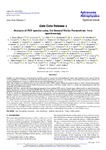Gaia Data Release 3: Analysis of RVS spectra using the General Stellar Parametriser from spectroscopy

Use este enlace para citar
http://hdl.handle.net/2183/35819
A non ser que se indique outra cousa, a licenza do ítem descríbese como Atribución 4.0 Internacional
Coleccións
- Investigación (FIC) [1687]
Metadatos
Mostrar o rexistro completo do ítemTítulo
Gaia Data Release 3: Analysis of RVS spectra using the General Stellar Parametriser from spectroscopyAutor(es)
Data
2023-06Cita bibliográfica
A. Recio-Blanco, et al., "Gaia Data Release 3: Analysis of RVS spectra using the General Stellar Parametriser from spectroscopy", Astronomy and Astrophysics, Vol. 674, A29, Jun. 2023, doi: 10.1051/0004-6361/202243750
Resumo
[Abstract] Context. The chemo-physical parametrisation of stellar spectra is essential for understanding the nature and evolution of stars and of Galactic stellar populations. A worldwide observational effort from the ground has provided, in one century, an extremely heterogeneous collection of chemical abundances for about two million stars in total, with fragmentary sky coverage. Aims. This situation is revolutionised by the Gaia third data release (DR3), which contains the parametrisation of Radial Velocity Spectrometer (RVS) data performed by the General Stellar Parametriser-spectroscopy, GSP-Spec, module. Here we describe the parametrisation of the first 34 months of Gaia RVS observations. Methods. GSP-Spec estimates the chemo-physical parameters from combined RVS spectra of single stars, without additional inputs from astrometric, photometric, or spectro-photometric BP/RP data. The main analysis workflow described here, MatisseGauguin, is based on projection and optimisation methods and provides the stellar atmospheric parameters; the individual chemical abundances of N, Mg, Si, S, Ca, Ti, Cr, Fe ¯I, Fe ¯II, Ni, Zr, Ce and Nd; the differential equivalent width of a cyanogen line; and the parameters of a diffuse interstellar band (DIB) feature. Another workflow, based on an artificial neural network (ANN) and referred to with the same acronym, provides a second set of atmospheric parameters that are useful for classification control. For both workflows, we implement a detailed quality flag chain considering different error sources. Results. With about 5.6 million stars, the Gaia DR3 GSP-Spec all-sky catalogue is the largest compilation of stellar chemo-physical parameters ever published and the first one from space data. Internal and external biases have been studied taking into account the implemented flags. In some cases, simple calibrations with low degree polynomials are suggested. The homogeneity and quality of the estimated parameters enables chemo-dynamical studies of Galactic stellar populations, interstellar extinction studies from individual spectra, and clear constraints on stellar evolution models. We highly recommend that users adopt the provided quality flags for scientific exploitation. Conclusions. The Gaia DR3 GSP-Spec catalogue is a major step in the scientific exploration of Milky Way stellar populations. It will be followed by increasingly large and higher quality catalogues in future data releases, confirming the Gaia promise of a new Galactic vision.
Palabras chave
Galaxy: stellar content
Methods: data analysis
Stars: Abundances
Stars: fundamental parameters
Methods: data analysis
Stars: Abundances
Stars: fundamental parameters
Versión do editor
Dereitos
Atribución 4.0 Internacional






